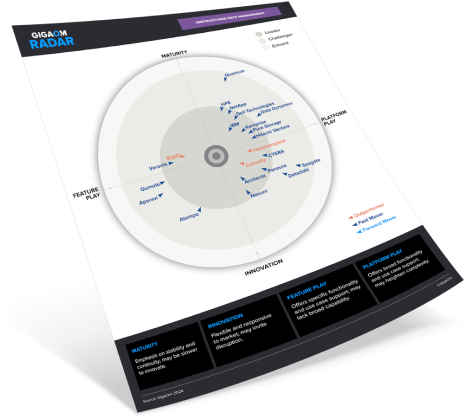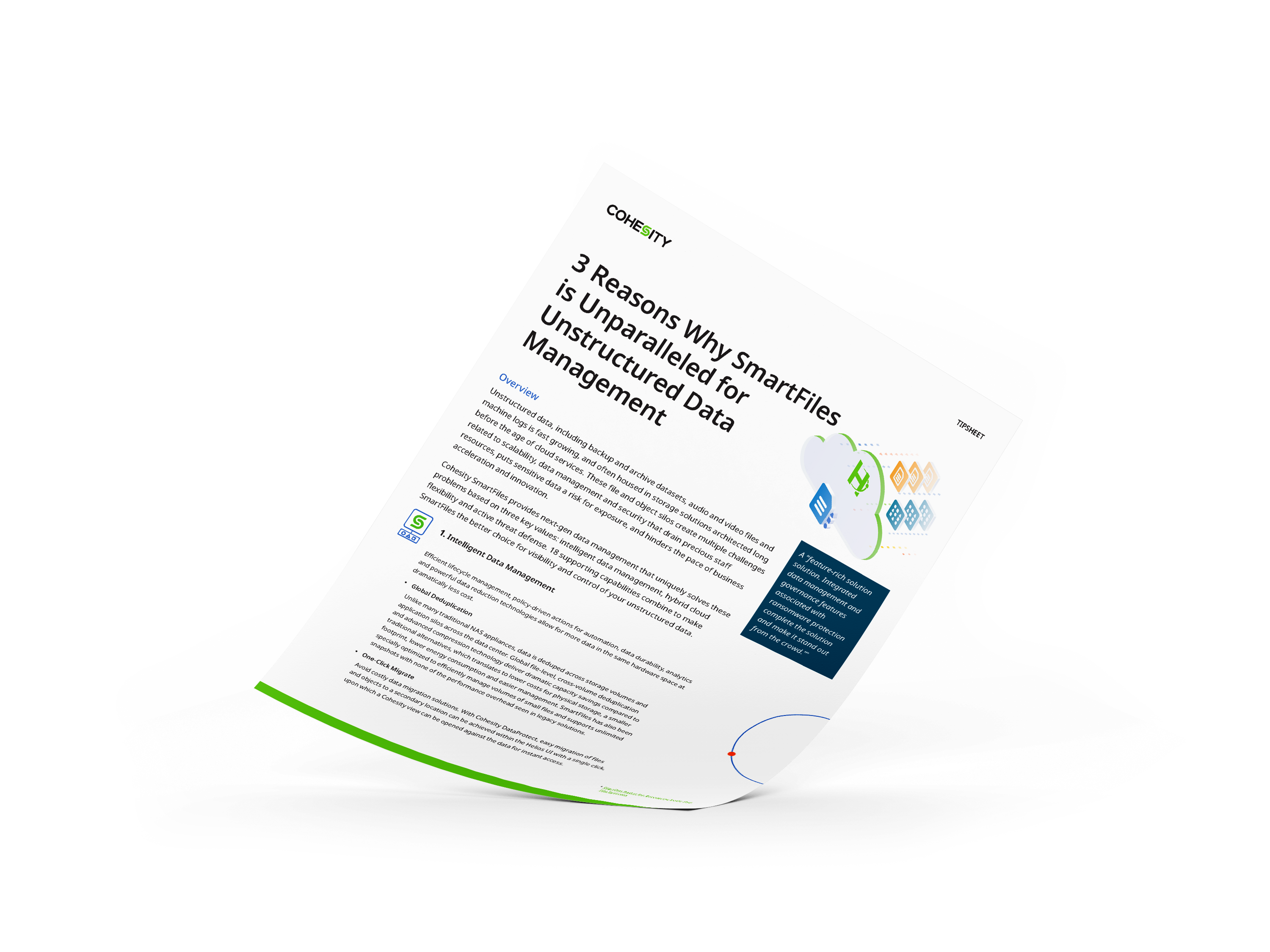Unlimited scale
Stay ahead of growing unstructured data demands by harnessing the power of a scalable software-defined hybrid cloud platform.
Scale, manage, and analyze your unstructured data with next-level intelligence, and protect your organization from emerging cyber threats.
Stay ahead of growing unstructured data demands by harnessing the power of a scalable software-defined hybrid cloud platform.
Lower costs and optimize efficiency with data reduction, automated tiering and archiving, and powerful search and analytics. All with one interface.
Protect data with enterprise security and integrated apps for compliance and malware detection. Identify PII and recover rapidly from ransomware.
Consolidate data management and modernize your enterprise infrastructure. Easily address your data growth with limitless, pay-as-you-grow architecture.
Scale your unstructured data without disruptive upgrades using software-defined simplicity and hybrid cloud flexibility. Expand across on-premises, edge, and cloud locations.
Safeguard your data with multifactor authentication, software encryption, key management, and RBAC. Defeat ransomware with anomaly detection and data entropy analysis. For added protection, easily isolate and quickly recover your Cohesity SmartFiles data from the cloud with Cohesity FortKnox. Detect risky user behaviors that could be indicators of a cyberattack or data exfiltration with Cohesity DataHawk.
Deliver seamless data access for your users and applications with simultaneous multiprotocol support for NFS, SMB, and S3. From one console, conveniently manage data globally—on-prem, at the edge, and in the cloud.

Reduce cost by up to 51%, increase operational efficiency, and improve business agility with SmartFiles.
Consolidate storage silos and reduce your footprint with 96x or greater data reduction. Lower TCO through and cross-volume deduplication, advanced compression, and small file optimization.
Effortlessly manage the lifecycle of your data with policy-based archiving and tiering of data based on age, access, size, and type for long-term retention and compliance.
Save time and money with an integrated data management ecosystem on a single platform. Ransomware protection, file auditing, and analytics run directly on your data without extensive infrastructure.
Manage, secure, and do more with your data with next-level software-defined file and object services for the hybrid cloud.
The smartest way to optimize cost, scale, and efficiency for your unstructured data.
Manage archive and backup datasets effortlessly. Reduce TCO and simplify management.
Easy-to-search document management. Manage files and objects securely and at scale.
Economically manage multimedia content for education, training, electronic communications, and more.
Seamlessly manage large-scale IoT and big data stores to simplify and accelerate analytics.
Cost-effectively archive, search, and retrieve surveillance footage with ease.
For eDiscovery and legal hold, collaboration, research, and documents.

Structured data is data that is stored in a fixed place within a file or record. It’s typically stored in a relational database (RDBMS) but can also be found in NoSQL databases, for example. Structured data can be text, dates, or numbers.
Unstructured data comprises file and object data and has not been defined or stored in a predefined way. Although most common unstructured data consists of text, it can also feature numbers, images, and audio. Unstructured data is used within every function in business. Examples include: Finance (invoices, forms), Healthcare (medical records and images), Public Sector (documents, research data), Manufacturing (design files), Marketing (photos), IT (IoT data), Sales (emails with customers), Customer Service (social media), and more.
Although it’s changing and accumulating rapidly, much of the unstructured data that is collected and stored is processed manually, if at all. For example, email is mostly processed by a human reading it, extracting what is important (sometimes by copying and pasting into another email or into an application), and taking action based on its contents.
But with advancing AI technologies such as machine learning, machine vision, and natural language processing, more of this unstructured information can be harnessed and analyzed automatically, driving faster business insight.
Object storage refers to a data storage architecture purpose-built to store and manage volumes of unstructured data. Each file is stored as an object. The object includes the file along with user-defined and application-defined metadata that includes information related to the file. Objects also feature a unique name, which can be used to find and access the object. Objects are stored in a large, non-hierarchical repository, or data lake.
File storage organizes files according to a logical hierarchy of files and folders. Folders are located in a directory and can also be nested within subfolders. File storage is commonly used for network attached storage (NAS) devices and personal computers. Files are located based on a path name that includes the associated directory, folder, and subfolder names, ending with the file name.
Organizations need data security and management strategies and solutions that keep up with evolving threats and minimize the increasing blast radius of ransomware. Cohesity SmartFiles, along with other integrated Cohesity data services, delivers powerful data security features so organizations can confidently defend their critical file and object data from cyberattackers and insider threats.
Cohesity SmartFiles consolidates siloed data management functions onto a single and scalable software platform capable of running multiple use cases at scale, and slashing complexity and cost. As a comprehensive global solution, the entire data management lifecycle can be conveniently managed from a single console.
SmartFiles supports a variety of native protocols for integration, including NFS, SMB, and S3. It simplifies data management by consolidating unstructured data (files and objects) from multiple application workloads. When you consolidate unstructured data on SmartFiles, you can manage it efficiently and securely with policy-driven actions. With simplified management via our global Helios UI, you can apply security and data protection policies to meet compliance requirements, create data lifecycle management policies to expire data, and automate data movement and placement across the datacenter and public clouds.
Cohesity can also help you optimize your existing NAS environments by alleviating capacity to maximize resource use. SmartFiles provides the built-in capability to identify infrequently accessed unstructured data, and automatically tier or migrate that data to SmartFiles. A modern approach to file and object management, SmartFiles eliminates costly forklift upgrades and time-consuming infrastructure updates while guaranteeing all of your unstructured data is protected wherever it resides—in the data center, the cloud, or at the edge.
The Cohesity Data Cloud allows you to run apps directly against data in place, without requiring extensive infrastructure, to streamline processing and accelerate results. With an extensive Marketplace ecosystem of third-party and Cohesity-developed apps, teams can save time and money with easy-to-deploy solutions for search, analytics, auditing, compliance, and security. Organizations can maximize the value of their data by easily integrating with leading familiar applications that can help unlock valuable insights to power intelligent business decisions.
Because the Cohesity Data Cloud was designed from the start as an API-first environment, it’s a developer win. Developers are empowered to use a rich set of RESTful APIs to easily integrate next-gen functions into their apps and create new capabilities.
